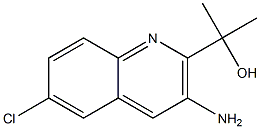Uses
Reproxalap (ADX-102) is an active aldehyde sequestering agent. Reproxalap reduces the PKCα activity. Reproxalap blocks caspase 3/7 activation. Reproxalap protects cells from the cytotoxicity of C18:0-al. Reproxalap has anti-inflammatory and pain-relieving effects. Reproxalap is used in studies of dry eye, allergic conjunctivitis, and non-infectious anterior uveitis[1][2][3][4][5].
in vivo
Reproxalap (30-100 mg/kg, once or twice a day) shows a dose-dependent reduction in pain-related behaviors in acute pain models[3].
Reproxalap (10 mg/kg, intraperitoneal injection, single dose) significantly reduces the formation of N-retinyl-phosphatidylethanolamine (A2E) in the retinas of mice with macular degeneration[5].
Reproxalap (25-50 μg, IVT, injected in five doses after LPS (HY-D1056) induction) can improve eye scores in uveitis rats[5].
| Animal Model: | Carrageenaninduced and Complete Freund’s Adjuvant (CFA)-induced models in mice[3] |
| Dosage: | 30, 100 mg/kg; once a day or twice a day |
| Administration: | |
| Result: | Was effective in thermal hyperalgesia in the CFA-induced model at both 100 mg/kg QD and BID doses; in the carrageenan-induced model, and was effective at 30 mg/kg BID and 100 mg/kg BID doses.
Was effective in mechanical allodynia only in the CFA-induced model at a 100 mg/kg BID dose; in the carrageenan-induced model, was not effective.
Had a mild effect on swelling in the CFA-induced model at 30 mg/kg BID and 100 mg/kg BID doses; in the carrageenan-induced model, had a mild effect at a 100 mg/kg QD dose. |
| Animal Model: | A mouse knockout model (abcr-/-) of macular degeneration (MD) [5] |
| Dosage: | 10 mg/kg; single dose
|
| Administration: | Intraperitoneal injection (i.p.) |
| Result: | Reduced the formation of N-retinylidene-N-retinylethanolamine (A2E) in the retina by 71% without affecting dark adaptation or body weight. |
| Animal Model: | A rat model of lipopolysaccharide (LPS)-induced uveitis[5] |
| Dosage: | 10 mg/kg
50 μg at hours 1, 3, 7, 10 and 17, after LPS induction, or injection 25 μg at 1 hour after LPS induction |
| Administration: | Intravitreal (IVT) |
| Result: | Improved the eye examination scores, enhancing the retinal-choroidal ratings. |
References
[1] Ochoa CA, et al. Aldehyde Trapping by ADX-102 Is Protective against Cigarette Smoke and Alcohol Mediated Lung Cell Injury. Biomolecules. 2022 Mar 2;12(3):393. DOI:
10.3390/biom12030393[2] Rizzo WB, et al. Sj?gren-Larsson syndrome: A biochemical rationale for using aldehyde-reactive therapeutic agents. Mol Genet Metab Rep. 2021 Dec 23;30:100839. DOI:
10.1016/j.ymgmr.2021.100839[3] Susan Macdonald, et al. ADX-102, a novel aldehyde trap, reduces nociceptive behavior in mouse models of carrageenan and CFA induced pain.
[4] Reproxalap Phase 2b Dry Eye Disease Results.
[5] Susan G. Macdonald, Ph.D., et al. Novel Small Molecule Aldehyde Sequestering Agents Demonstrate Broad Therapeutic Potential for Ocular Inflammation.

